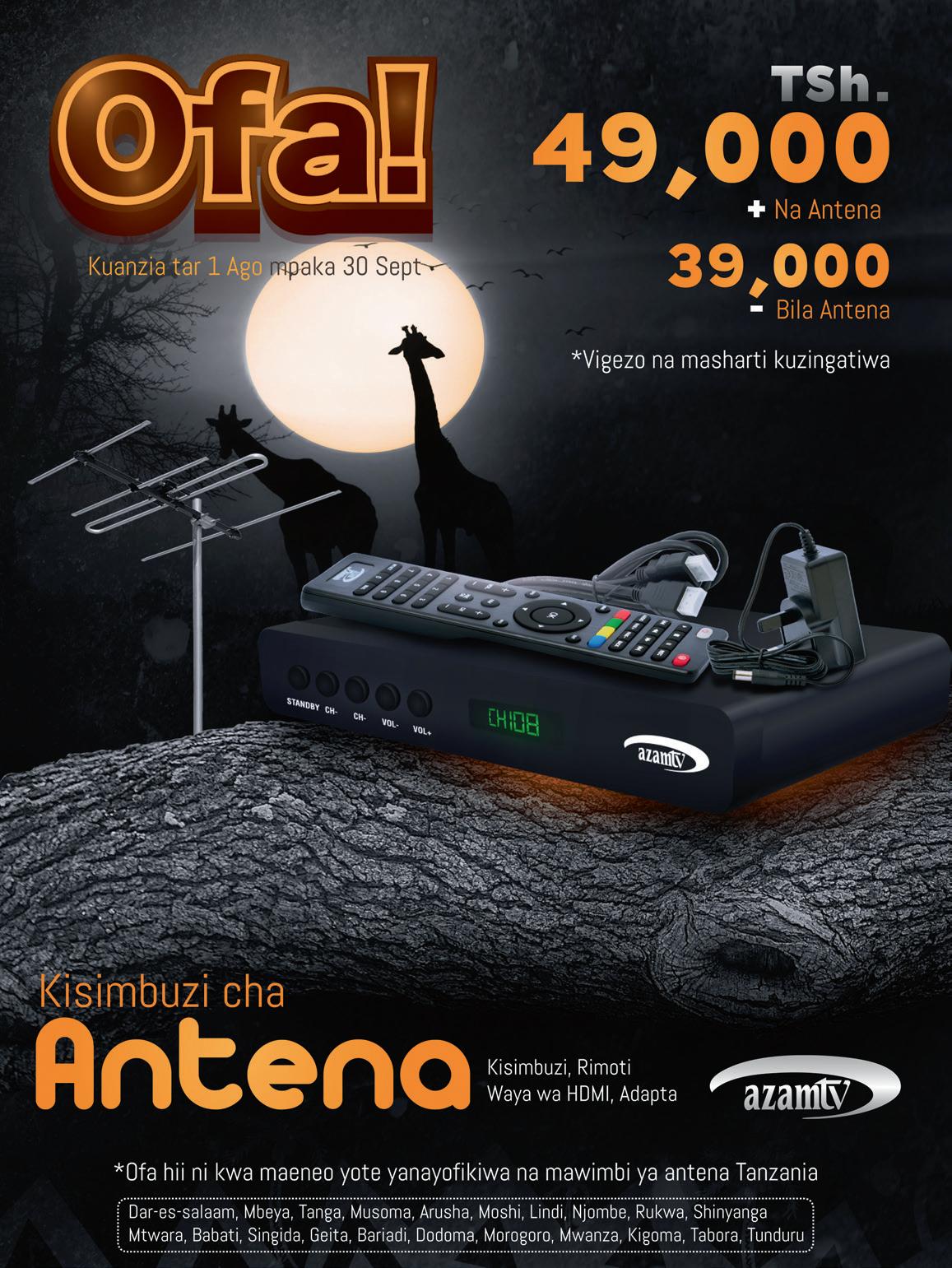Natural beauty
How Tanzania’s riches inspire photographer Imani Nsamila
The road less travelled A guide to tourism away from the crowds

Chimpanzee community
The protected primates of Mahale Mountains National Park

Also inside RUNNER’S STORY My Ultra X experience Issue 10 Kilimanjaro Fast Ferries Your Free Kilimanjaro Fast Ferries Magazine
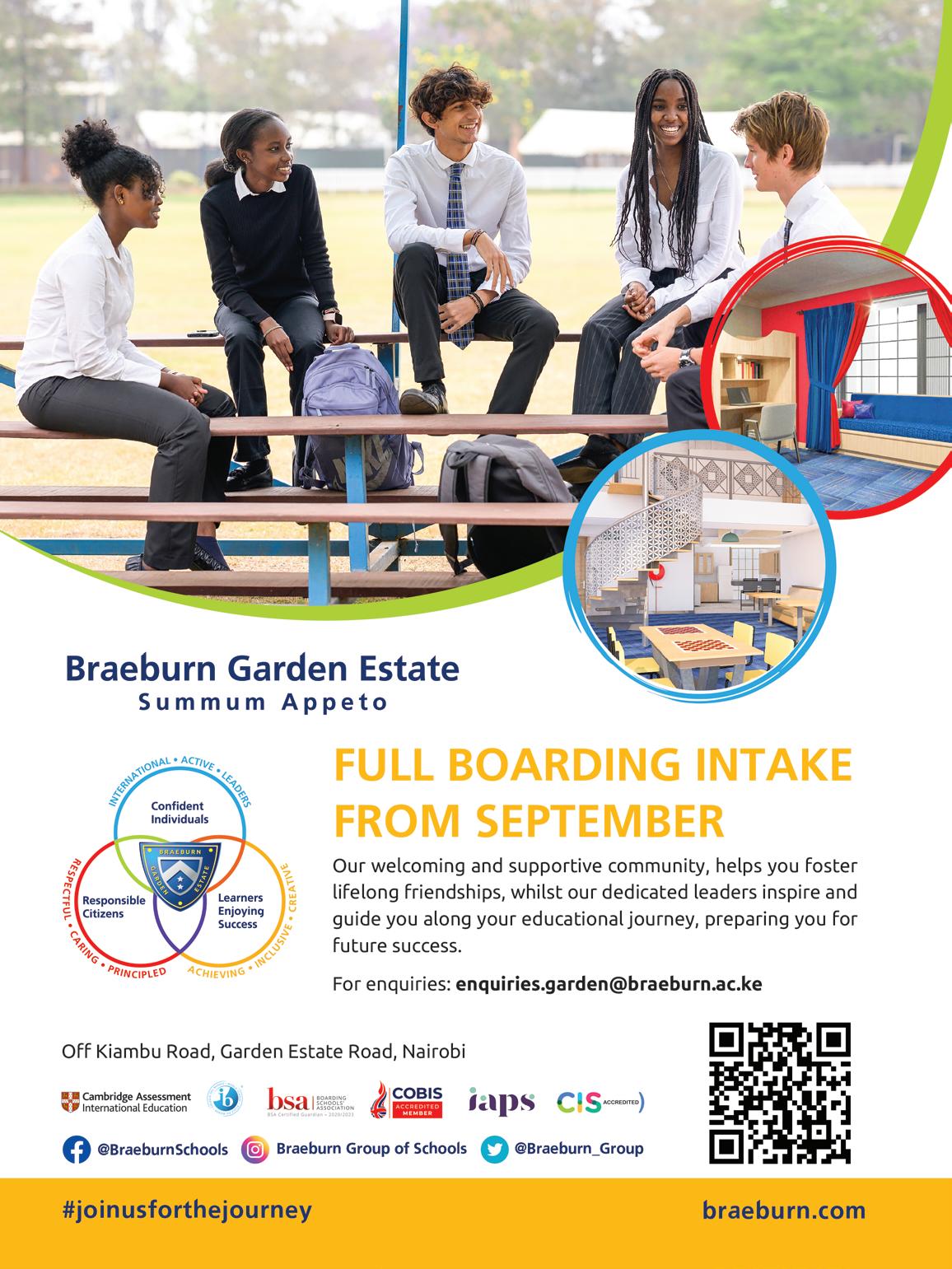
Jahazi is the official magazine of Azam Marine and Kilimanjaro Fast Ferries
Opposite St Joseph Cathedral Sokoine Drive, PO Box 2517
Dar es Salaam, Tanzania
Tel: +255 22 212 3324
Email: info@azammarine.com
Web: azammarine.com

Jahazi is published by: Land & Marine Publications (Tanzania) Ltd
4th floor, Josam House Block A, along Coca Cola Road Mikocheni Area, Dar es Salaam
Tel: +255 686 118 816 www.landmarine.com

Advertising sales:
Godfrey S. Urassa


Tel: +255 (0) 686 118 816 (WhatsApp)
Email: godfreyurassa@landmarine.com
Editor: Mark Edwards markedwards@landmarine.com
Head office:
Land & Marine Publications Ltd.
6 The Square, Ipswich, Suffolk, IP5 3SL UK

Tel: +44 (0)1206 752 902
Email: publishing@landmarine.com
Jahazi is printed by:
Jamana Printers Ltd, Dar es Salaam
The opinions expressed in this publication are not necessarily those of the editor, or any other organisation associated with this publication. No liability can be accepted for any inaccuracies or omissions. ©2023 Land & Marine Publications Ltd.
10
Feature
3 Welcome Safari njema
Dugong in numbers
Prize Winning Photography Imani Nsamila, photographer of the year
pages
7
8
Which Tanzanian Island is right for you Here’s our pick of more than 50 islands and islets that make up the Zanzibar archipelago 13 5 Best Secret Beaches of Pemba 15 Jackline Chris Spreading the word on positive self-talk 18 How to be an untourist Follow your own tourist path 21 Mahale Chimpanzees The forested slopes of the Mahale Mountains are home to a protected population of chimpanzees 26 A Stylish Stay in Stone Town The five-star Neela Boutique is one of Stone Town’s newest luxury hotels 28 Snakes on a plain My Tanzanian ultra running adventure 31 Light up your Lounge Interior lighting to show off your home 34 Bob Junior Farewell to the King of the Serengeti 36 Forever Angels Securing a home and health for orphaned children Jahazi regulars 5 Azam News Jahazi onboard 25 Competition 38 Technology review Sports Tech 41 Our fleet 43 Travel information Our services, travel tips and schedules 44 Our destinations 47 Route maps 1 Kilimanjaro Fast Ferries book online at azammarine.com In this issue 10 36 Bookings: azammarine.com +255 22 212 3324 Follow us: @azammarine kilimanjaro fastferries officialazammarine 21 15 Read Jahazi online: https://qrs.ly/kef39in

Safari njema

It is my pleasure to welcome you onboard your ferry crossing with Azam Marine and Kilimanjaro Fast Ferries, the number one ferry company in East Africa.

We started out with just one vessel, the MV Muungano, but now have a fleet of air-conditioned catamarans that provide the best possible services for Tanzanians with our latest addition to the fleet, the Kilimanjaro VIII, now ready to go (see pages 8 and 9 for details on the ferry’s official launch). Our passengers are very dear to us and we have made great efforts to ensure your experience with us is a positive one all the way from booking your tickets to the moment you arrive at your destination.
Our online ticket purchasing system is a quick and easy way to plan and pay for your journey in advance. Boarding is similarly hassle free thanks to the design of our vessels and our carefully organised boarding protocols. Once we are under way, passengers can sit back and enjoy the journey with in-cabin features such as personal entertainment systems and a range of available refreshments competing for your attention with the spectacular Indian Ocean views from the cabin windows. Our ferry crossings are safe and speedy and deliver you right into the heart of Stone Town or Dar es Salaam for your business or leisure engagements.
Another bonus to travelling with us is getting to sit back and enjoy the latest edition of our onboard magazine, Jahazi! Once again, we have brought together the people and places that make the Tanzania mainland and Zanzibar so special.
You can now keep up with the latest Azam Marine and KFF news as well as some amazing images of our fleet in action on our new Instagram page @azam_marine
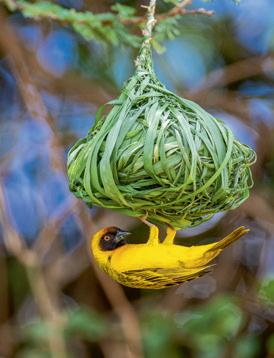
‘Your Safety is our Priority’. Kilimanjaro Fast Ferries www.azammarine.com 3 Kilimanjaro Fast Ferries book online at azammarine.com Welcome Karibu Issue 10 RUNNER’S STORY My Ultra X experience Issue 10 Kilimanjaro Fast Ferries Your Free Kilimanjaro Fast Ferries Magazine Natural beauty How Tanzania’s riches inspire photographer Imani Nsamila Chimpanzee community The protected primates of Mahale Mountains National Park The road less travelled A guide to tourism away from the crowds Follow us: @azammarine kilimanjaro fastferries officialazammarine

Latest News
From the Azam group of companies
Why ferries are the ultimate in hassle-free travel

The holiday starts immediately when you take an Azam Marine ferry with easy checkins and incredible views. Here’s a few reasons why it should always be Azam.
Kid-friendly
Rather than getting frustrated and fidgety in a cramped aircraft, children have room to roam on a ferry and they will love the adventure of a ferry trip as well on the choice of onboard entertainment.
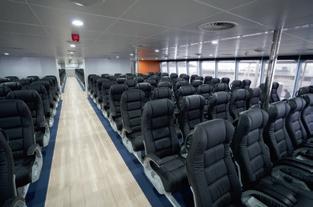
The excitement of arrival
Nothing can match that first glimpse of the first sliver of land when your ferry is approaching its destination. If you are heading to Zanzibar port, you are blessed with the unforgettable view of historic Stone Town.
It’s the easiest way to travel
Choosing the plane or the car to travel takes a lot of stressful preparation. It’s so easy to arrive at the port just one
hour before with your ticket booked online at azammarine.com
More choice of trips
Four smooth and quick crossings a day between Dar es Salaam and Zanzibar Island mean you can go at a time that suits you.
It’s cheaper
Whether you travel in economy or in style with our business and VIP options, there are travel options for all budgets and all far cheaper than aircraft travel.
Bookings
We are here to help
Now
Follow
With four trips a day (launch times are 7am, 9.30am, 12.30pm and 4pm) there’s no more convenient or comfortable way to travel between Dar es Salaam and Zanzibar Island. Call 0800 785555 to book a spot.
5 Kilimanjaro Fast Ferries book online at azammarine.com
you can book your Azam Marine ticket online and pay by phone or by credit card. Visit azammarine.com
us: @azammarine kilimanjaro fastferries officialazammarine

Dugongs in numbers
Once called the ‘sirens of the sea’ and thought to have inspired the original mermaid tales, dugong sightings have become increasingly rare off the Tanzanian coast. Here’s some facts and figures about these magical mammals.
70 years
Dugongs can live to this ripe old age.
360kg
The weight of the largest males is considerable. They can also grow to a length of 3.4 metres.
10 km/hour
The average cruising speed of a dugong
Two
Adult dugongs are distinguished by their two ‘tusks’. Males and females have six cusped (with bumps or points) molars in each jaw, which fall out progressively until only these two remain.
25 metres
The length of a dugong intestine. A diet consisting of coarse vegetation such as seagrass requires some serious digesting and passage can take up to five to seven days.
2005
The date of the last authorised sighting of a dugong off Tanzanian waters. There are still populations to be found off the East African coast with a few hundred left in the protected waters of the Bazaruto Archipelago National Marine Park off the coast of Mozambique. The dugong is categorised as ‘vulnerable’, though there are moves to have that upped to ‘critically endangered’.
In Africa, dugongs are known as nguva, which is Swahili for ‘mermaid’. It may seem odd to confuse a slow-moving sea cow with a beautiful, fish-tailed maiden, but the mistake seems to be a worldwide one dating back centuries. They are also known here as simply binadamu, meaning ‘person.’
11 minutes
As mammals, dugongs have to hold their breath under water, but they can manage it for a long time with over 10 minutes not unusual.
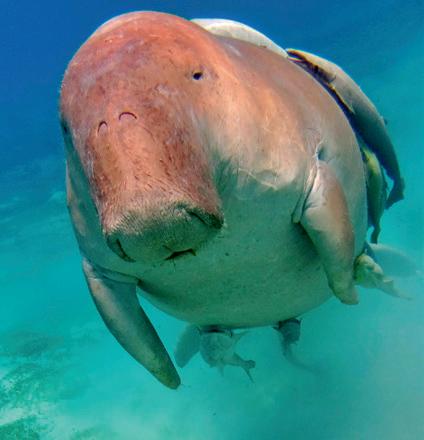

7 Kilimanjaro Fast Ferries book online at azammarine.com Zanzibar marine life
‘Nguva’
Agami Photo Agency /
Shutterstock.com
Vitaliy6447 / Shutterstock.com
PRIZE-WINNING PHOTOGRAPHY
In July Imani Nsamila was announced as the Photographer of the Year at the Tanzania Digital Awards. The award recognises a photojournalist with a track record of creating images that influence. One of the Tanzanian’s earliest jobs was as official photographer for former President John Magufuli during the 2015 elections and he has gone on to bring attention to environmental hardships in the country as well as the innovative schemes introduced to resolve them. Recently his work has been commissioned by international media outlets such as The Guardian in the UK, a development that has brought him the opportunity to share his African stories with the world. With RwandAir flying to Tanzanian destinations Dar es Salaam and Kilimanjaro, here are recent examples of Imani’s work that celebrate his homeland.
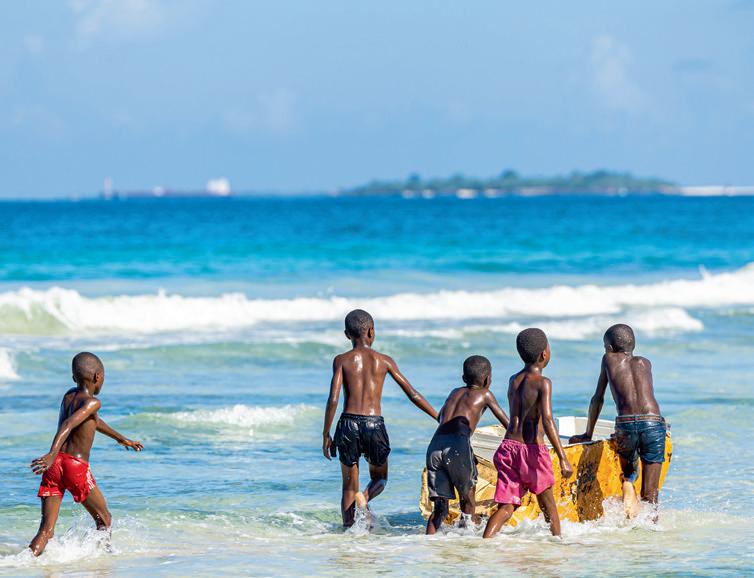


8
IMANI NSAMILA - PHOTOGRAPHER OF THE YEAR







9
book online at azammarine.com
Kilimanjaro Fast Ferries
WHICH ZANZIBAR ISLAND IS RIGHT FOR YOU?

More than 50 islands and islets make up the Zanzibar archipelago. Some are little more than a scoop of sand, but the primary islands offer a mix of ancient culture, bountiful nature and some of the world’s best beaches. Here’s our pick of the highlights of each to help you make your choice.
The one for enjoying Swahili culture in style…
WHERE? UNGUJA (also known as Zanzibar Island).
WHAT? This is very much the daddy of the Zanzibar archipelago’s holiday options: at 1,666 sq km it is bigger and brasher than the others and with a huge choice of luxury hospitality options to ensure you enjoy your island break in style.
WHY? High-end hospitality investment has hit the island in a big way so while there is no end of spectacular hotels to choose from, off-grid escapes are rare. Still the popular coastal areas of Paje

in the south-east and Nungwi in the north still maintain a balance between sleepy fishing village and beach side resort. Inland, the Jozani Forest – Zanzibar’s only national park – is a great escape with walking trails and canoe trips through the mangrove swamps.
MUST SEE: Wandering Stone Town – the old port area of the capital city – is essential to soak up Swahili culture. While you’ll now find plenty of exclusive hotels, boutiques, restaurants and bars within its winding streets, the Unesco Heritage Site is still a living museum, showcasing ancient architecture and a way of life of life that have gone unchanged for centuries.
Take in a taarab (traditional Swahili music) concert, explore the bustling markets and reflect on the port’s dark past at the Old Slave Market.
The one for an untouched island adventure…
WHERE? PEMBA
WHAT? About 80km northeast of Unguja, Pemba is the archipelago’s second largest island. Early Arab sailors called it ‘El Huthera’, meaning ‘The Green’, and it is still largely a fertile paradise of gently rolling hills, fragrant clove farms, lush forest and coral reefs teeming with marine life.
WHY? Pemba is a serene escape with the locals paying scant
10 Zanzibar Islands
Protection of island wildlife is essential
Image: Oz Eran / Shutterstock.com
There is a wealth of luxury options to choose from
attention to what few tourists arrive and little to get in the way of whiling away your stay on its white sands with the occasional dip in the sapphire waters.

Tranquil as it is, Pemba’s natural treasures provide a wild playground for active visitors. Jump on bicycles to explore traditional villages and ancient ruins or take to the crystalline waters for swimming and kayaking. The Pemba channel is reputed to offer the best diving in East Africa with untouched coral reefs, bath warm water and superb visibility.
MUST SEE: There was a time when Pemba was covered almost coastto-coast in tropical forest. Now
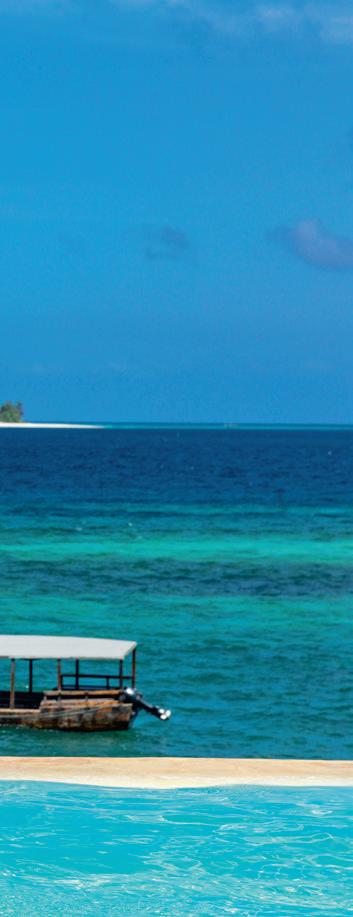
just a section remains, the Ngezi Nature Reserve, but its doublecanopy denseness still presents a magical world to visitors where bird life abounds and vervet monkeys swing from vines. There are trails for guided tours with the longest reaching Vumawimbi Beach while night tours offer the chance to spot the forest’s endemic nocturnal denizens such as the Pemba scops owl and gigantic fruit bat, the Pemba flying fox.
The one to ensure you leave the lightest of environmental footprints…
Where? CHUMBE ISLAND
WHAT? This small private island a few km off Unguja was uninhabited until, in 1991, its forested land and surrounding coral reef was developed as a nature reserve. A visitor and education centre, nature trails and amazing diving opportunities are now offered to day visitors who arrive by boat from Unguja while the recent building of an eco-lodge with beach restaurant means guests can enjoy longer stays.
WHY? Everything is run here with state-of-the-art eco-technology – rainwater harvesting, solar energy and solar water heating, composting toilets and vegetative greywater filtration – aimed at zero impact on the environment. The eco tip-toeing extends to protecting the island’s rare wildlife such as Ader’s duiker, roseate terns and marine turtles. Humpback Whales.
MUST SEE: One of the island’s strangest denizens is the coconut crab with a 300-strong population thriving here. After dinner, overnight guests have the chance to encounter the world’s largest land-living land crab on a walk into the coral rag forest. At this
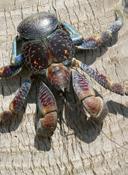
time these scavengers are on the look-out for food with – as their name suggest – coconut a favourite on the menu with the giant crab using its curved and claw-like legs to scale the island’s palm trees for their high-hanging fruit. .
The one for unforgettable close-up encounters with whale sharks…
Where? MAFIA ISLAND (Kisiwa cha Mafia in Swahili)
WHAT? The Mafia archipelago is made up of five islands – Jibondo, Juani, Chole, and Mafia. The latter is the third largest island in Zanzibar and situated 160 km to the south of Unguja. Much of the southern stretch of its coastline is protected by the Mafia Island Marine Park, the largest protected area in the Indian Ocean and seasonal home to marine giants such as whale sharks.
Kilimanjaro Fast Ferries book online at azammarine.com 11
Coconut crabs climb palm trees looking for food
Image: KYTan / Shutterstock.com
Its pristine reefs and plankton-packed waters mean Mafia Island offers some of the best diving in the world
OSTILL is Franck Camhi / Shutterstock.com
Stephen Butler / Shutterstock.com
Zanzibar Islands
WHY? Its pristine reefs and plankton-packed waters mean Mafia Island offers some of the best diving in the world. The season to swim with filter-feeding whale sharks here is the longest in the world with trade winds pushing a layer of plankton packed ocean water towards the island, encouraging the sharks to linger here from September to February. The waters here are also an excellent spot to watch humpback whales make their way up and down the coast as part of their annual migration. Add in incredible secluded beaches such as Ras Kisimani, just across from Bwejuu Island, and Utende Beach, which edges onto Chole Bay, and you have the perfect aquatic adventure holiday.

MUST SEE: As well as its marine-life packed ocean depths, Mafia Island has a deep cultural history. Like Unguja, has long been a crucial and cosmopolitan stop-off for Indian Ocean shipping routes. The remains of its trading heyday, dating back to the 13th Century, can be seen in ruins such as those at Kisimani Mafia – evidence of
what is thought to be the earliest settlement on the island.
The one for an exclusive island paradise…
Where: MNEMBA ISLAND
WHAT? This tiny – about 1.5km in circumference – private island located 3km off the northeast coast of Unguja that houses a luxury beachside resort for just 24 guests.

WHY? This is the ultimate in barefoot luxury accommodation. The
andBeyond resort has 12 beachside bandas just footsteps from the cerulean waters and a few swimming strokes from the Mnemba Atoll, a coral reef that encircles the island and provides one of the best scuba and snorkelling spots in Zanzibar with hundreds of species of colourful marine life including darting before your eyes. This is an exclusive escape – billionaire philanthropist Bill Gates is a regular (and rumoured owner) here – and can feel like you have your own private island at times. However, if you ever need some TLC, the resort has two staff to every guest and sumptuous services within the shade of the island’s casuarina pine forest include massage, yoga and even a plate of sushi at sunset if that takes your fancy.
MUST SEE: While human guests on the island are restricted to just a select few, Mnemba does have plenty of wild inhabitants. Its beach is a popular nesting spot for green turtles and during hatching season – usually between February and March – hotel guests can join experienced staff on a sunset trip to see one of the wonders of the natural world as the hatchlings make their tentative trip to the ocean.
12
Whale sharks are a must-see
A Mafia Island home right on the beach
Image: SkyNex/ Shutterstock.com
Tony Myshlyaev / Shutterstock.com
PEMBA BEST SECRET BEACHES


The lush, hilly landscape of the ‘Green Island’ of Pemba hides some spectacular, often deserted beaches. Here’s Jahazi’s guide to these secret sands. If you know, you know.

provide some of the best diving in East Africa. Nesting hawksbill turtles favour the western side of the island while inland from the beaches are caves believed to be home to the spirits of ancestors.
3
MBUYUNI BEACH
1
VUMAWIMBI BEACH
This idyllic 3km stretch of beach in Pemba’s north-western corner is among the island’s most popular, yet there is still a good chance you and your party will be the only ones leaving footprints in the flawless white sand. Shrouded by the thick foliage of Ngezi Forest, the best way to access the beach is by dhow and once the fishing boat steers into this deserted cove, you’ll feel like you’ve discovered paradise.
2
On the eastern side of the Kigomasha peninsula on Pemba’s northern tip, you’ll find some of the island’s most remote yet rewarding beaches. They are inaccessible by four-wheeled vehicle but hire a bicycle or a pikipiki scooter and weave through the woods and you’ll come upon a series of untouched beaches with the best of them, Mbuyuni, offering thatched huts for an overnight stay.
4
MISALI ISLAND
Just another boat ride away is Misali Island – an uninhabited piece of paradise that is part of a protected area which covers Pemba’s entire west coast. The beaches here are beautiful and just a short swim out will get you to the pristine coral reefs that halo the island and
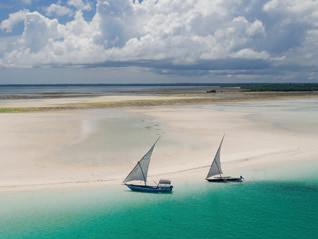
RAS KIUYU
This promontory affords fantastic views of Pemba’s north-western coastline with the beach stretching as far
as the eyes can see. Getting here is an adventure in itself as you’ll need to navigate the Ras Kiuyu Forest, which is teeming with rare bird life and stretches all the way to the coast. Making your way through the tree cover to come out onto this untouched beach is a reveal time will never erase.
5
KIGOMASHA PENINSULA
This spot at the northernmost point of the island offers incredible views and diving opportunities. Most people visit to take in the Ras Kigomasha Lighthouse, which was built 115 years ago to warn colonial ships of the treacherous promontory. The remote location is protected and there is an entrance fee to look around the lighthouse, but the excellent surrounding beaches and turquoise waters. Nearby village Makangale also offers the chance of cultural visits for tourists.
13 Kilimanjaro Fast Ferries book online at azammarine.com
Top five
Gideon Ikigai / Shutterstock.com
Robin Batista / Shutterstock.com
Robin Batista / Shutterstock.com
Lukasz Nycz / Shutterstock.com

Spreading the word on positive self-talk
Author and activist Jackline Chris is seeking to motivate young Tanzanians through positive self-talk. Her collection of original feel-good quotes – published in 2021 as ‘Hundred Sentences’ – got her through her own dark times and she continues to spread her upbeat message through her online wellness platform and community events across the country.

Jackline Chris understands the power of words. Having studied journalism at the University of Dar es Salaam and gone on to become a communications manager with youth empowerment programme Brac International, she knows how to craft a sentence to move, inform and captivate the reader.
However, the 27-year-old Tanzanian well remembers a time when words held sway over her – with the cruel taunts of others and her own obsessive negative self-talk making her feel so low she considered taking her own life.

Jackline traces those self-sabotaging thoughts back to childhood. She grew up in the low-income Tandale suburb of Dar es Salaam with two older sisters and a younger brother and parents who worked hard day-by-day to provide for their family. Always an awkward child, Jackline’s fragile self-confidence took repeated knocks at primary school with her high, soft voice making her a target for bullies. “They who would call me kubana pua [the Swahili for ‘stuffy nose’] because I talked like I was pinching my nose,” she says.
I talk to Jackline over the
15 Kilimanjaro Fast Ferries book online at azammarine.com
Jackline Chris
phone from Morogoro, eastern Tanzania, where she is overseeing a photoshoot for Brac. I hear a confident young woman far removed from the softly spoken youngster she describes – “my voice has upgraded,” she tells me – but those early scars took time to heal. Hiding away through her teenage years, she remained shy, naïve and awkward. “I truly believed if I sat down next to a guy at that time, I would get pregnant,” she says. “I was also always dropping stuff. I had a friend who was a bit older who would tell me I was clumsy when I was around her and that negative self-image just grew deeper. I suffered for a long time.”
Journalism
When Jackline won a place at university to study for a BA in journalism, her father managed to get enough money together to fund her tuition fees. With no loans from the university available to her, that left Jackline to finance her accommodation and upkeep. She sold everything from fruit to women’s tights and organised events to support herself, but it was a non-stop struggle. While more solvent students were out enjoying themselves in the evening, Jackline, shilling-less and feeling friendless, would keep to her student accommodation. Though she maintained a sunny demeanour in public the lack of money coupled with the perfectionist pressure she put on herself when it came to her studies would conjure intense bouts of self-criticism. “If I couldn’t get something right the negative thoughts would start to spiral,” she says. “I started hearing voices inside telling me that I was a failure.”
She recalls her lowest point. It was a weekend. Her period started, but she had no money to buy sanitary pads and no credit on her phone to ask for help. Not wanting to stain her

bed with blood, she remained sat on her chair all day while feelings of despair rose within her.
“In those hours sitting down there was a lot going on in my mind,” she says. “It was so humiliating. I began obsessively thinking I can’t take it anymore and that I was just a nuisance to people. I had suicidal thoughts.”
It wasn’t until the late evening that one of her sisters called and Jackline got the help she needed. Help like this from family and friends always served to ground her. “The kindness of others healed me,” she says. “If I heard ‘asante’ from another person, I would brighten immediately.”
Jackline thought about how she could pay that goodwill forward and spread it to others suffering their own internal turmoil. At university she had been coming up with motivational sentences that she would write down and repeat mantra-like at times of self-doubt. Among her inspiring and thought-provoking aphorisms were: “You live for a cause, not applause”, “If I am to make others believe then it should start with me that I believe in order to make others do the same” and “be a fan of yourself before everyone else is.”
“Reading them back would deflect my pattern of negative thoughts,” Jackline says. “So, I thought I should share them online with other students. Straight away people began telling me how they had helped them.”
Graduated
By the time Jackline graduated, she had composed around 300 of the quotes. Those that resonated the most made it into her first published work, the anthology Hundred Sentences. The student online community has also been scaled up and out with a new platform called Power of Sentence that gives young Tanzanians
– from teens into their 30s – an opportunity to share their mental health stories without stigma. Jackline says that while words can be weapons, the platform helps people find “their own voice and strive beyond labels and negative self-talk”.
“I launched the platform for people to share their experiences,” she says. “Words have a big impact, but our monthly meetings are a safe place to confront the limiting beliefs that used to define you.”
The virtual meeting place is now expanding into live events with Jackline organising regular outreach activities such as a recent visit to a rehabilitation centre in Bagamoyo.
In Tanzania, mental health care is limited and predominantly focused on pathological conditions that require hospitalisation. Employing a therapist for one-to-one sessions is prohibitively expensive for most people here, but platforms such as Power of Sentence offer a low-cost, scalable option.
“My events are free and as simple to join in as a conversation,” Jackline says. “I want people to know if they are going through

Jackline Chris
16
Jackline Chris on a community clean-up Jackline’s second book, released in May
something now there is no need to panic. There is help. They don’t need to worry about the cost of seeing a professional as I am in contact with a couple of psychiatrists who offer their services free and sit in on some of the sessions.
“When I was suicidal, there was no help out there. So many people need access to mental health. They suppress feelings until they burst out as anger or suicide. Power of Sentence is there to help make a change. My hope is one day it will prove the necessary push to set up a national mental health helpline.”
Jackline credits working with Brac International for much of her new-found confidence and ambition. She started working for the Bangladesh-based development organisation, which encourages young people to pursue their potential and start their own businesses, while still at university. Once she had her degree, she was offered a permanent position as a communications officer and in two years had reached management level. “Brac has brought me stability,” she says.
Operations
While she is busy spreading the word on the organisation’s operations across its 112 branches in Tanzania, Jackline continues to make her mark with more personal projects.
In May this year, she released her second book, The Amnesia. The fictional work focuses on a young man who brings his city girlfriend to meet his family in the country, a visit that spurs the realisation that he has no memory of his early life.
Jackline says the book is actually a rewrite of a story she first composed in 2015 while she was still a high school student.
“The original was stored on a laptop that collapsed and I lost the
work. Last year I rewrote it and as I’m financially stable now, I decided to publish it.”
That financial independence has also enabled Jackline to purchase her own home in the Mikocheni area of Dar es Salaam and her latest philanthropic project began with her regular evening fitness walks to the neighbourhood’s coastline behind Palm Village, where she was dismayed at the amount of discarded rubbish on the beach.
Waste
“It was disturbing to me that I would find a lot of waste and it would grow day by day,” she says. “One day I sat down with one of the locals who told me they needed a leader to push them into regular clean-ups.
“I managed to get 10 volunteers interested in the first clean-up using tools like rakes I’d borrowed from friends.”
Now two years on the villagers wake up each Saturday morning to organise their own clean-ups there has been as many as 250 volunteers on a single day to help.
Jackline had recognised that it was not a waste problem, but
10 powerful sentences
a community problem and by encouraging a change in behaviour she was able to make a difference. She is now expanding that model with a campaign, Serving Waters, to improve coastal or lake-side environments in Dar, Zanzibar, Kigoma and Mtwara.
In Dar she already has the backing of the beach locals and local government, and Serving Waters has so far organised 20 coastal clean-ups.
Jackline continues to spread the word on this and her other projects. She owns her voice now and is determined to be heard.
Taken from Hundred Sentences by Jackline Chris
Trust is not a switch that you can turn on and off.
If you will never pour water out of the cup, you will never get a refill. Give so that you can receive.
You live for a Cause, Not Applause.
Paint your mind with positive thoughts. Sit back, relax and enjoy a colourful life.
You have something great in your head. Unless you put it out for the world to see, no one will ever know you do.
Believe this; the journey gets more exciting when they start to say things that are determined to break you. And you, on the other hand, use the same words to build yourself.
If it does not make sense then you should.
Nothing is ever too big, if you are strong enough to know it, you are strong enough to face it and eventually beat it.
If it is not from the heart, it can be torn apart.
If you do not say it, they will not hear it.
17 Kilimanjaro Fast Ferries book online at azammarine.com
When I was suicidal, there was no help out there. So many people need access to mental health. They suppress feelings until they burst out as anger or suicide. Power of Sentence is there to help make a change
How to be an untourist
FOLLOW YOUR OWN TOURIST PATH
Heading for tourist hot-spots on your vacation may seem a good idea on paper, but you’ll get a deeper connection to Tanzania (or any other destination) away from the crowds and the clichés. Here are just some of the advantages of taking the path less travelled.
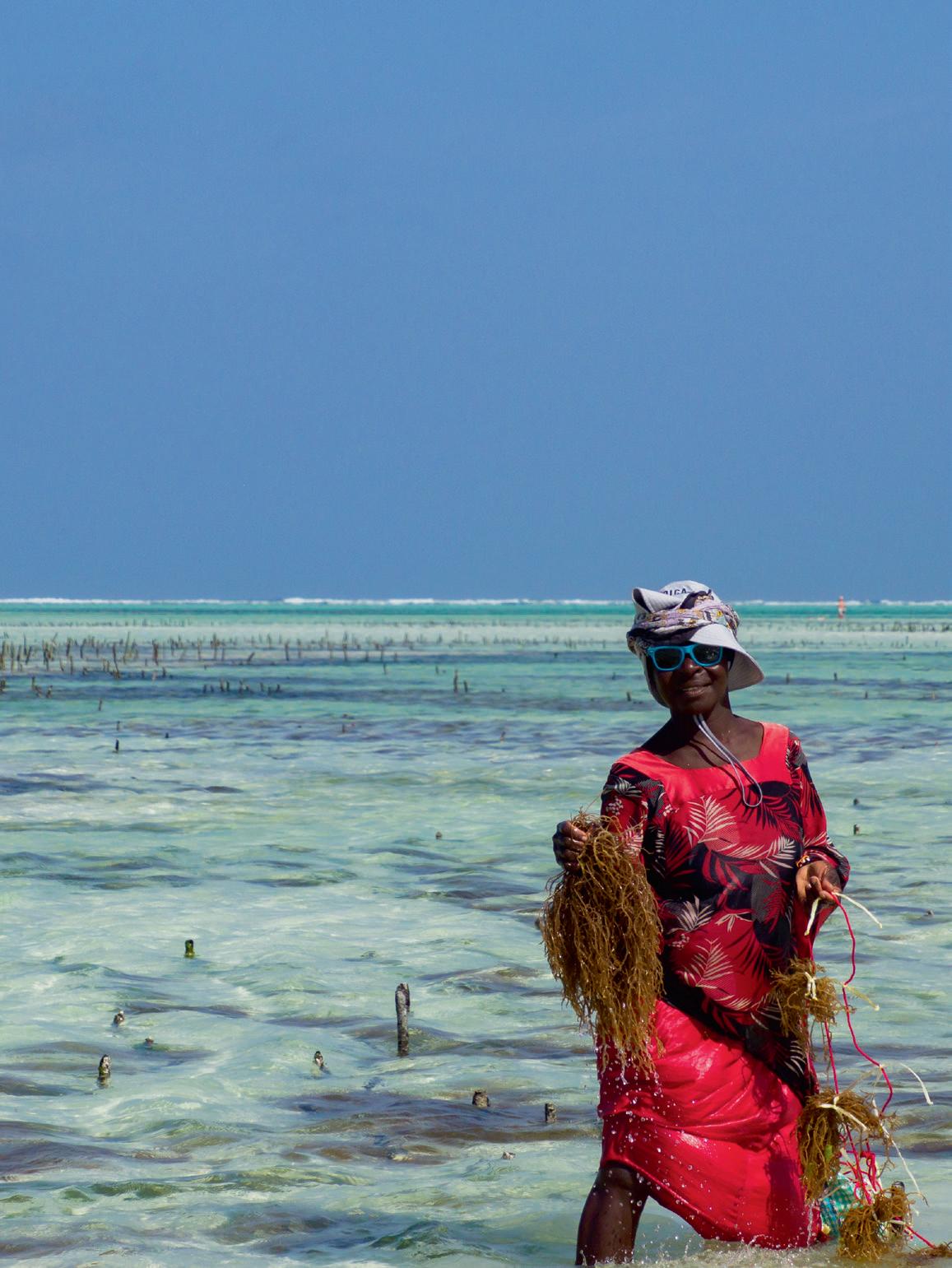
18
Meet the locals
If you really want to immerse yourself in the rhythms of life in the place you are visiting, spend time with the locals. Zanzibar offers some fascinating opportunities for this. Jaws Corner, a coffee shop in a courtyard amid the winding lanes of Stone Town, is a great place to chat while sipping some strong Zanzibar coffee. You’ll find friendly locals sitting on benches under a large mural of a shark emerging from the water – hence the shop’s name – and you may find one even invites you to play popular local board game Bao. If you’re strolling the beaches in the early morning, look out for the mamas wading in the shallows to tend their seaweed farms. Observe and be polite and they may show you how they carry out this environmentally friendly role that has become a major part of Zanzibar’s Blue Economy. Also at low tide, you will likely see locals searching rock pools carrying a spear. Unless you’re an octopus, there’s nothing to be alarmed about.

During a single low tide, a skilled octopus hunter can spear more than 10 of the slimy invertebrates, which thrive amid the maze of rocks and are a delicacy on the islands. When you are exploring, get a local to be your guide. Whether it’s
navigating you through labyrinthine Stone Town or a fisherman taking you out on his dhow to one of the islands, there is much insider information to be gleaned.


Give back
As well as meeting the locals, why not seek out ways to empower them? That could be by supporting local businesses with your souvenir purchases or joining in on initiatives that maintain the environment you have enjoyed during your stay. There are regular beach clean-ups organised in Dar es Salaam and Zanzibar. They are an opportunity to get some exercise, meet new friends and leave a place you love even better than you found it. It may even inspire you to return for a longer stay as part of volunteer programme. Zanzibar projects include the Turtle and Coastal Conservation in which volunteers can work alongside local marine biologists to help boost wild turtle populations and protect the coastal environment.
Go off-grid
Firing up Google Maps will get you to your destination via the quickest route, but the joy of the journey will be lost head down in your phone. Our dependence on
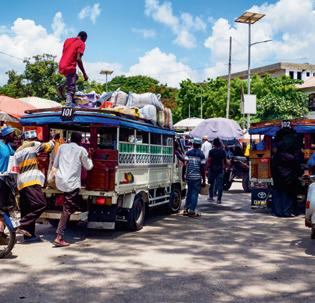
19 Kilimanjaro Fast Ferries book online at azammarine.com
Ventura / Shutterstock.com
Jana Kollarova / Shutterstock.com
Nowaczyk / Shutterstock.com
Nowaczyk / Shutterstock.com
technology and gadgets can blind us to the beauty of life in the moment. Far better to be guided by chance and instinct. So, jump on a packed dala dala to your destination and soak up the noise and life going on through the windows. Part of the joy of Stone Town is get lost in its circuitous streets and stumbling upon hidden gems. You could also take a bike ride around the 50 sq km Jozani Forest. Bring a guide with you that allows you lead the way yet is there to bring you safely home once you’ve explored enough.
Soak up the food scene
Visiting Zanzibar is a sensory experience and tasting from its vibrant food scene provides real insight into the culture here. Swahili cuisine creates flavoursome magic from the islands’ wealth of spices and fresh seafood so indulge yourself. There are food tours to local villages in Zanzibar that give you the chance to lend a hand in preparing local dishes. Street food is hugely popular here. While Forodhani Market draws the tourists at sundown, you’ll find local food being prepared everywhere – from women stirring cassava in a Swahili cooking pot for the day’s meal or spices drying in the sun – be curious and ask questions and you’ll get a true taste of Zanzibar.
Stay outside the tourist zone

Keeping your holiday experience as authentic as possible starts with your accommodation. You may have good intentions of pursuing a free-range experience while away, but if you are staying in a resort packed with tourists that is going to be tough. Best then to look for accommodation in districts that are primarily residential areas. They will be cheaper, will present far more opportunities for interaction with the locals and no crowds pursuing a generic tourist experience.
Learn the language
You don’t need to get fluent in Swahili before you arrive, but learning some key phrases – hello, please, thank you, goodbye, sorry – will be welcomed and break the ice when speaking to the Zanzibari you meet. Apps such as Drops or Duolingo both have Swahili among the languages they teach and make learning fun and easy. Bahati njema!
Don’t photograph your holiday away
Taking photographs on holiday is a great way to hold onto memories, but it is possible to get carried away, believing the key to making great, lasting memories is to make photographs of everything and everyone. Consequently, tourist hotspots are often a mass of selfie taking. However, being present in the moment and absorbing our experiences has been proven to fix them in our memories far better than mindless camera clicking. Best to make each picture count and put some thought into each one. To ensure your holiday snaps are to be treasured forever, you can book a tour with a professional photographer who will offer tips on best capturing the spectacular scenery of the Tanzania coast.
Create your own souvenir
If you are going to avoid the generic trappings of tourism that should extend to the souvenirs you buy as holiday keepsakes. Bringing home a tea towel, a fridge magnet or a key ring might be traditional, but you can do much better. Dar es Salaam art hub Make It Matter has classes in which you can create crafts with local artisans and bring back the unique results while animal shelter Every Living Things offers the chance to adopt a rescued animal and offer them a better life. Knowing you’ve made the world a slightly better place is a souvenir to cherish.
20
How
You could also take a bike ride around the 50 sq km Jozani Forest. Bring a guide with you that allows you lead the way yet is there to bring you safely home
to be an untourist
M.Pakats / Shutterstock.com

21
book online at azammarine.com
Kilimanjaro Fast Ferries
Phil Hyde / Shutterstock.com
Mahale
Chimpanzees MEET THE MAHALE CHIMPANZEES
Mahale Chimpanzees
The
forested slopes of the Mahale Mountains
National Park in western Tanzania are home to a protected population of chimpanzees. Here Beatrice Nicholaus of award-winning wildlife filmmakers and storytellers Ngoteya Wild reveals how time spent with human’s closest relative in the wild reveals a complex community that helps the primates survive and thrive.
On the forest trails of Mahale Mountains National Park, you will get within an earshot of man’s closest kin before you even get to see them. Their facial expressions are strikingly similar to those used by humans as they convey different information about mood, status, danger, food, and various social interactions. Chimpanzees share 97% of our DNA, making them closer to humans than gorillas.
Chimpanzees are the focal point of Mahale, but they are far from the only attraction the park has to offer. Lake Tanganyika’s crystal-clear waters are framed by mountains extending for 50 km and splitting Mahale into two unique natural habitats: evergreen forest to the west that receives high annual rainfall and the eastern miombo savanna characterised by dry and wet seasons. The park is home to ten primate species, including yellow baboon, vervet monkey, Angola colobus, blue monkey, red-tailed monkey and ashy red colobus.
Community dynamics
Among the chimpanzees, visitors can observe a fascinatingly complex hierarchy at work.
Up to 100 chimpanzees live in extended communities that share a territory. Social bonds between unrelated females are very weak, whereas maternal bonds between
males and mothers are strong. Male chimpanzees remain within their traditional home range, spending their entire life within their birth community and defend it against rival neighbours. Females regularly migrate to a neighbouring community after reaching adolescence.
In chimpanzee’s society, leadership is often more political with the alpha male being more of the chairman of the board rather than a tyrant. Adult males are fiercely intolerant of their neighbouring groups and occasionally kill solitary individuals or small groups close to the community’s territorial boundary. Such rivalry has boiled over in Mahale with some males seizing the moment when they know the neighbouring community males are smaller in size than them.
Foraging and adaptations
Chimpanzees’ feeding behaviours and dietary preference depend on the seasons and rely on botanical expertise, knowing when and where to find fruiting and flowering trees. They will spend just over half the day foraging with morning and late afternoon being the peak foraging hours. Chimpanzees are mostly herbivores, preferring to eat fruit but they will also snack on leaves, stems, flowers, seeds and shoots.
Before the 1960s, chimpanzees were believed to be purely herbivorous, but the work of Jane Goodall in Gombe National Park and Japanese researchers in

22
Social bonds within groups are complex yet fascinating Chimpanzees will spend just over half the day foraging
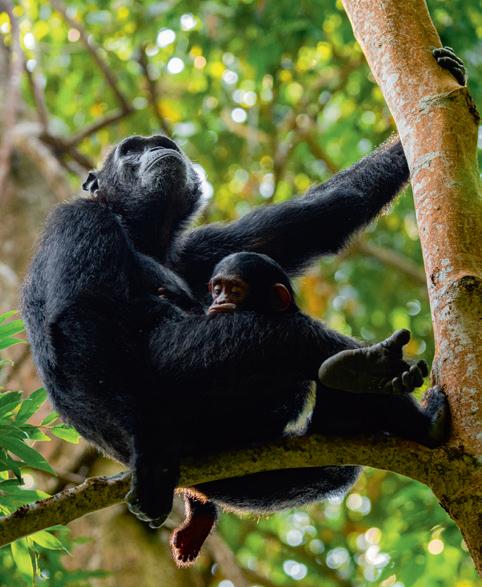
Mahale uncovered a non-vegetarian component to the primate’s diet. Goodall discovered that chimpanzees were not only omnivorous but opportunistic foragers with carpenter ants, birds’ eggs and nestlings on the menu too. Additionally, they discovered how surprisingly creative chimpanzees were in fashioning tools when it came to foraging and sourcing medicinal and recreational food sources. Chimps are keen hunters, known to take down small mammals through an ambush strategy with each individual playing a specific role. There is a ‘flasher’ that makes himself visible to the prey to create panic and drive them into the path of ‘blockers’ who in turn coral the prey into the ‘ambush zone’ where the strongest chimps capture the prey. On a successful hunt, other chimps sit close and beg for a share, but the one who made the kill has undisputed rights.

23
Fast Ferries book online at azammarine.com
Chimps are keen hunters, known to take down small mammals through an ambush strategy with each individual playing a specific role
Kilimanjaro
Nesting
Wherever the chimpanzees forage last is the ideal camp site for the night. They are expert nest builders with juveniles learning the art from around eight months old. Chimps start by choosing a perfect spot with crossing or crocheting branches as the foundation of the nest. Then smaller branches are broken or bent and woven over and under one another before adding leafy branches for padding and finally laying down comfortably after a long day.
Unique behaviours of the Mahale chimpanzees
Chimpanzees’ behaviour changes over time due to adaptations to new environments, habitat degradation or climate change. However, some changes are evolutionary, such as speech. Recent observations have found that chimpanzees communicate with recognisable speech.
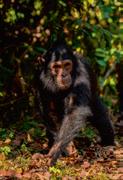
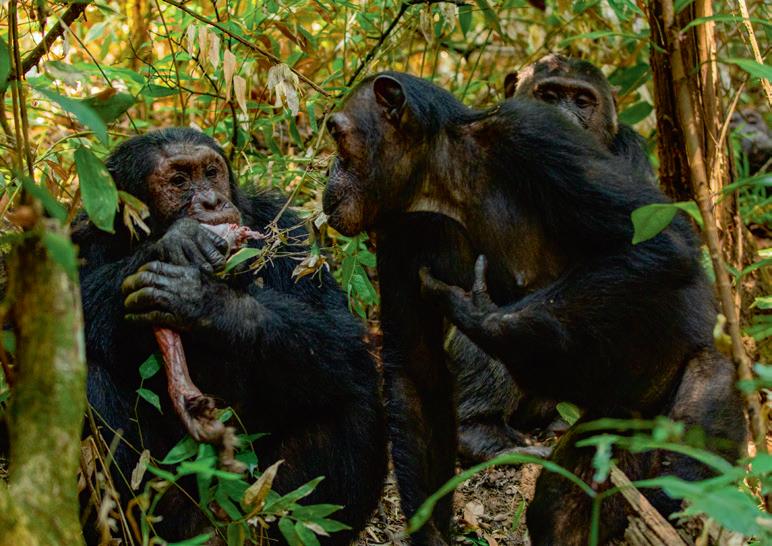
The Mahale chimps also show a newly observed behaviour, known as “the high five – a form of communication that mostly
occurs during grooming and which was first captured on film in Mahale Mountains National Park.
Another interesting behaviour observed among the Mahale chimps is ‘lip-smacking’. This form of communication has many functions within the chimpanzee community. It is a social behaviour that brings about friendly interactions among the chimps, it is also a sign of submission, affection or contentment and a way to prolong grooming when grooming vulnerable parts of their body.
Chimpanzees and the community
As part of ensuring the Mahale chimps can maintain a healthy natural life, rules and guidelines had to be set up regarding human access to them. A maximum viewing time of one hour is set once a chimpanzee has been located, no person under the age of 12 is allowed, and no more than six individuals plus a qualified guide can get close to the chimpanzees at one particular time.
Visitors must wear a mask at all times and not get any closer than 10 metres to the chimps. Anyone suffering from a cold or other infectious illness is not allowed in contact with the primates. Wild chimpanzees’ immunes systems are susceptible to human diseases – especially respiratory illnesses – so these strict rules are essential to protect them.
The secret ingredient to Mahale chimpanzees’ prosperity can be traced years back to when the park was first gazetted. Between 1975 and 1980 moves to preserve Mahale sanctuary as a game reserve took place and people of the resident Tongwe tribe were transferred to areas outside the park. It took until 1985 to formally establish National Park status, a lengthy process that gifted Mahale with a transition zone outside the boundaries with no human settlements. Additionally, there is a wildlife corridor to Katavi National Park which adds to the diversity and health of the ecosystem. The local communities surrounding the Mahale National Park by far are more focused on small-scale fishing and its benefits so poaching and land degradation no longer threaten the chimps’ livelihood.
Mahale is a great example of how nature and humans can live in harmony, respecting each other’s space and sustainably utilising their common grounds. A truly unique and treasured national park and one you have to see to truly appreciate.
Ngoteya Wild
In July, Ngoteya Wild premiered its film ‘Mahale Chimp Guardians’, which unravels the story of the national park as a biodiversity hotspot through the words of Mzee Bunengwa, a guide born and raised in Mahale who focuses on chimp conservation. For more details, visit ngoteya_wild on Instagram.
24
The Mahale chimps show different forms of communication
Visitors follow strict guidelines when near to the chimps
Mahale Chimpanzees
10 ways to ease stress
Competition A chance to win A VIP return trip from Dar to Zanzibar
How to enter
To be in with a chance of winning this prize, answer the three questions below (they are all based on features in the magazine where you’ll find the answers). Email the answers, along with a photograph of you holding Issue 9 of Jahazi on your KFF journey to competition@landmarine.org by the closing date: 10 October 2023.
Answer these three questions
How many tusks do adult dugongs have?
What is the name of the third largest island in the Zanzibar archipelago?
Which primate is the Mahale National Park famous for?
Competition terms and conditions: Prizes dependent on availability. One entry per person. Entrants must be 18 years or over. The decision of the organisers will be final. The competition is not open to employees and their relatives of Kilimanjaro Fast Ferries, Azam Marine or Land & Marine Publications Ltd. The prize does not include travel to and from destinations.

How do you like the idea of traveling between Dar es Salaam and Zanzibar in VIP style and all for free? Well, that’s exactly what’s on offer in Jahazi’s prize competition this issue. Thanks to Azam Marine and KFF, one lucky winner will win a VIP return ticket from Dar ferry terminal to Stone Town port on Zanzibar Island. The journey across the Zanzibar Channel will be experienced in comfort and luxury in the catamaran’s VIP Lounge. They can relax in the
Last issue’s winner
Congratulations to Mohammed Somani. who wins a VIP return ticket from Dar to Zanzibar in comfort and luxury aboard one of KFF catamaran’s VIP Lounges
airplane-style leather seats and enjoy the great views and plenty of natural light from the surrounding floor-to ceiling windows. The winner will also enjoy free wi-fi, their own personal entertainment console with a library of films and TV programmes, complimentary drinks and snacks and – surely best of all – the latest issue of Jahazi to read at their leisure.
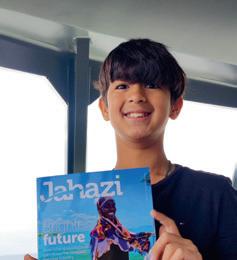

25 Kilimanjaro Fast Ferries book online at azammarine.com
A stylish stay in Stone Town
The five-star Neela Boutique is one of Stone Town’s newest luxury hotels, yet in retaining the architectural heritage of one of the former coastal trading hub’s most storied buildings it immerses its guests in the town’s Swahili soul.

Location
Stone Town is Zanzibar’s cultural and commercial heart with its ornate, ancient buildings testament to its former wealth and influence as the primary Indian Ocean trading post in the 19th century.
The Neela Boutique Hotel Zanzibar occupies one of the town’s most prominent buildings. Before the Neela makeover, the impressive harbour-side property housed the Zanzibar’s government’s Ministry of Education and now affords the hotel’s first guests – it only opened for business in August – priceless rooftop views across the city’s skyline of minarets and spires and out over the glistening ocean. Stone Town itself is just a 10-minute taxi ride from Zanzibar Airport and is an ideal base for an island adventure. The hotel’s location means it is just footsteps from the labyrinthine streets of the old town – which are packed with shops, restaurants, museums, bars and music venues that showcase Swahili culture – as well as being within easy reach of white-sand beaches and the plethora of ocean-going craft, big and small, lining up to take you to nature
reserve off-shore islands or the diving paradise of the surrounding coral reefs.

Atmosphere
The historic building has been meticulously restored into a luxury boutique hotel. Internationally renowned interior designer Nelly Levin has created a modern, crisp aesthetic that features calico-coloured walls – emphasising the spaciousness of the high-ceilinged rooms and cool courtyards – punctuated with carefully considered statement furniture pieces that reflect the building’s heritage. Locally sourced wood is used in the carved wooden doors – an emblematic feature of Stone Town’s grandest homes
– roof beams and wall art.
The hotel doesn’t overpower its guests with the antique aesthetic, though, as there are plenty of modern touches such as grand bathrooms with walk-in showers and claw-foot freestanding baths.
Rooms
The 14 deluxe and superior rooms are airy, cool and fantastic haven from the heat and hustle of Stone Town. Each comes with air conditioning, a seating area, a flatscreen TV with satellite channels, a safety deposit box and a private bathroom with free toiletries and bathrobes. The deluxe rooms have either king size or twin beds
26
Neela Boutique
The 14 deluxe rooms offer a cool retreat Sunset views from the beach
with an en-suite bathroom and a large walk-in shower. The superior rooms all have king size beds as well as a luxurious standalone bath located in the room with a separate en suite bathroom. Each room reflects the individuality and character of Stone Town.

Food and drink
Swahili cuisine is renowned for its international fusion of influences and rich in spices grown in the farms that pepper the Zanzibar archipelago. This coastal cuisine is showcased at Neela’s outdoor restaurant, Breadfruit, which offers a range of light bites and salads as well as an extensive a la carte
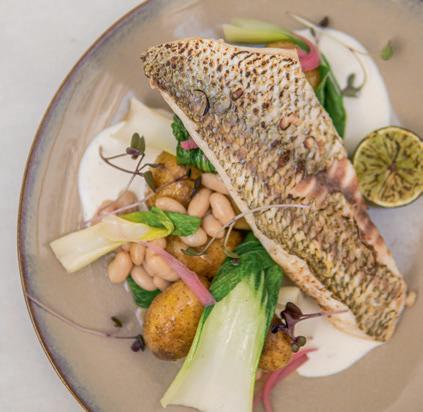
menu. The restaurant also has a team of expert baristas to brew your morning coffee just as you like it.
For drinks, the hotel’s rooftop bar and lounge, Views, offers an everchanging list of cocktails perfect to enjoy as the sun goes down over the city.
Facilities
Among the Neela Boutique Hotel’s senior staff is a guest relations director that curates excursions and experiences on the islands for hotel guests. Whether it is a sunset cruise on a traditional dhow fishing boat followed by a meal at Breadfruit, an afternoon sail to the Blue Lagoon, swimming with

dolphins, kitesurfing or a walking tour of Stone Town, your Zanzibar adventure starts here. The hotel can also provide catering for all your outings.

More information
For more information on the hotel, rates and booking information, visit neelacollection.com or email contact@neelacollection.com
27 Kilimanjaro Fast Ferries book online at azammarine.com International
cuisine served from hotel’s restaurant
Swahili cuisine is renowned for its international fusion of influences and rich in spices grown in the farms that pepper the Zanzibar archipelago
SNAKES ON A PLAIN
My Tanzanian ultra running adventure

Ultrarunning has arrived in Tanzania. The inaugural five-day, 250km Ultra X race – following a route that takes you part of the way up Mount Kilimanjaro – was held in March this year. Lily Canter was among the competitors and here she shares her experiences.
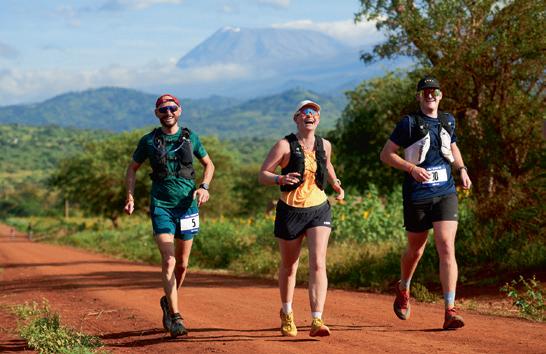

28 Ultra X Tanzania
Two gleaming silver eyes, glared at me in the pitch black. Frozen to the spot, I blinked again, and my sleep-deprived brain slowly whirred into action. “It’s just a monkey,” I laughed deliriously to the runner next to me as I began shuffling forward.
It was 4am on day four of the inaugural Ultra X Tanzania and things were getting weird. The 250km race across five days, includes more than 5,000 metres of elevation including a hike to high altitude on Mount Kilimanjaro. One minute you’re running on dusty tracks, inhaling red sand and the next you’re wading through thick jungle trying to ignore the shredded snake skins littering the ground.

Before entering I had only run a couple of 100km events in Snowdonia and the Lake District in the UK and had no idea what would happen to my body on day three. Turns out you just keep going.

With checkpoints holding water, medics and physiotherapists at 10km intervals, each day could be


broken into chunks, making the distance more manageable.
Day one broke us in gently with a 35km stretch commencing at the stunning ridge of Lake Chala. We jogged along flat rocky tracks, across sandy plains and around sunflower fields in a seemingly remote rural area. The welcoming local farmers greeted us enthusiastically with repeated cries of “hujambo” as they went to work in the fields.
Hot and bothered
Setting off at the civilised time of 7.30am meant we hit the mid-morning sun early on, and within a couple of hours it was roasting. As we gradually climbed 800 metres through sun-parched fields I started to wonder if completing the event was really possible. My stomach was already a mess following my dehydrated breakfast and there was no escape from the blazing sun.
Thankfully at the penultimate checkpoint a gentle breeze began wafting across the plains and we were buoyed by local children singing a good luck song while performing a Mexican wave. After a long downhill stretch, we entered the final 5km and while my competitors were waning I was finally getting into my stride. A last push saw us climb back up to camp and I finished strong after four hours of running.
Fortunately, day two was more overcast as we set off towards the highlands at 6.30am. The 49km route began with a slog across sandy farm tracks followed by a two-hour uphill walk-through lush banana plantations. As we marched up, we were met with an array of fist-pumping children who created a wonderful uplifting vibe despite the
29 Kilimanjaro Fast Ferries book online at azammarine.com
The afternoon sun made running almost impossible, plus my left knee had doubled in size
Competitors were surrounded by spectacular scenery
All images courtesy of Luke Jarmey
Tanya Keisha / Shutterstock.com
1,348 metres of constant climbing. The day finished with a steep up and down along slippery tracks through the forests, with some stunning views across Kilimanjaro.
If I was ever near breaking point, it was on day three. It began at 5.30am with a mesmerising run through the grassy baboon-filled meadows of Marangu, but then we hit Kilimanjaro National Park and the dream shattered.
The next 9km was a battle of will as I slogged my way up the 5km access road before a step-by-step 4km steep climb through the jungle to the Maundi crater. After the hard climb my mood immediately lifted thanks to the thrilling downhill


technical run back along the same path I had just struggled up. The last 20km were in the 30°C midday sun but I didn’t care because it was almost all downhill which was the perfect way to end a 51km day with 1,905 metres of elevation.
I was looking forward to a flatter route the next day as we ran 67km back down onto the plains, the skyline framed by the looming peak of Kilimanjaro. But starting at 4am meant a 2am wake up and running for two and a half hours in complete darkness. With little help from my hopeless head torch, I found the rocky paths incredibly tricky to navigate and began seeing hallucinatory shapes in the dark.
But once the sun rose there was a marvellous 8km downhill stretch through sunflower and sugar cane fields before we hit the deadly flat for the final 35km. I hooked up with another competitor as we ambled along the Miwaleni Canal trying to spot crocodiles and putting the world to rights.
The afternoon sun made running almost impossible, plus my left knee had doubled in size. So, we spent the final 20km walking through a nature reserve watching monkeys steal food from the surrounding fields. After an 11-hour day we were delighted to arrive at our final camp and find a fridge full of soda and beer in the middle of the savannah.
Final day
With a lie in until 5am I started the final 48km day feeling mentally fresh and determined to put in a good time. Knowing that hill climbing was my biggest weakness I decided to make up time on the flat while the weather was still relatively cool.
From the outset I joined a team of faster runners, and we ran a steady 9km through flat sandy jungle paths. I then pulled ahead at the first checkpoint and hammered it along the road to the bottom of the climb.
What followed was a horrendous 850-metre ascent up technical steep rocks with nothing but blue ribbons marking the way. There was no obvious path through the rocks and brambles and despite the sky being overcast I was soon drenched in sweat due to the high humidity. I laboured on with my running poles as a succession of 25 runners overtook me.
Treacherous descent
The descent was no easier, in fact it was far more treacherous, with numerous competitors falling and bashing their arms, legs and heads. Somehow, I managed to scramble down without slipping and hit the final 19km straight. Counting from one to 100 on repeat I managed to run my fastest segment of the week knowing the end was in sight. I overtook flagging runners en route and finished with a time of 40:06:02, even managing a sprint at the end as fellow competitors cheered me on.
The only moment I ran faster was at the celebration dinner at a local plantation that evening, where all the Ultra X competitors raced to get their hands on real food. It was also the location of my only scare of the week when I was cornered by a black snake in the plush toilet cubicle. And this time I wasn’t hallucinating.
30 Ultra X Tanzania
Lily finds a running partner
We were delighted to arrive at our final camp and find a fridge full of soda and beer in the middle of the savannah.
LIGHT UP YOUR LOUNGE
Living rooms are the heart of the house and illuminating them requires careful thought. Here, contemporary furniture curators Covet House present some eye-catching ways to create a remarkable first impression and show off your home in the best light.



INTERIORS 31 Kilimanjaro Fast Ferries book online at azammarine.com
(Above) The Burj Chandelier by Luxxu is inspired by one of the most stunning hotels in the world, the Burj Al Arab
(Top) The Botti Chandelier by DelightFULL instantly takes us into a music concert inspired by the jazz musician Chris Botti
The Empire Chandelier by Luxxu is inspired by the stunning architecture of The Empire State Building.
With





32
The Babel Pendant Lamp by Luxxu blends perfectly into placid and splendid interior design ambiences.
matte white and a nickel-plated finish, the Scofield Floor Lamp by DelightFULL can be customised with any RAL colour of your choosing.
Everything sparkles under the elegant Waterfall Rectangular Suspension Lamp by Luxxu.
Duke Round Suspension Lamp bu DelightFULL is a modern design that boasts a heavy nostalgic 70s groove vibe.
All images courtesy of Covet House
The Botti by DelightFULL is a midcentury floor lamp, handmade in brass with a gold plated finish that reminds of a real trumpet due to its unique shape.



33
book online at
Kilimanjaro Fast Ferries
azammarine.com INTERIORS
Botti Pendant Lamp by DelightFULL is a slightly smaller version of the modern chandelier with 15 trumpet-shaped shapes that stretch out from the centre
The Horus Suspension Lamp by Brabbu features a structure in matte black lacquered brass and shades in matte brass.
Farewell to the King of the
KING OF THE SERENGETI

Bob Junior, the mighty lion who once ruled over the Serengeti, was a remarkable animal that captivated the hearts and minds of all who had the privilege of seeing him. He was a true king of the jungle, with a majestic presence that exuded power and glory.
Spotting majestic male lion Bob Junior has been the highlight of a safari in the national park for visitors for over a decade. However, earlier this year rangers revealed the longtime leader of his pride was killed in a fight with younger rivals. Samana Karim celebrates the King of the Serengeti’s life and reign.
As the son of the legendary Bob Marley lion, Bob Jr – also known as Snyggve – inherited many of his father’s distinctive features, including his striking mane and commanding presence. He was a symbol of strength and resilience, a testament to the beauty and power of the natural world.
For seven years, Bob Jr and his brother Trygve Marley ruled over the Serengeti, protecting their territory and ensuring the safety of their pride. Despite being only 10-12 years old, Bob Jr was already one of the longest-living male lions in the area,

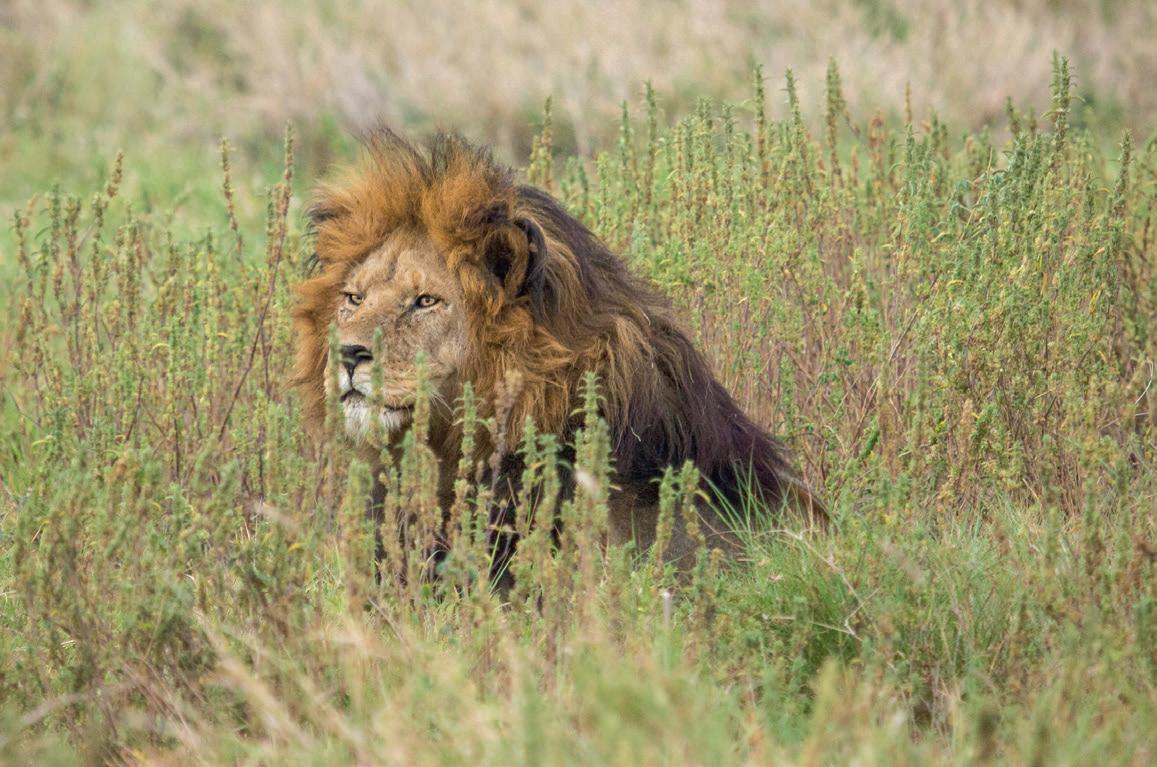
second only to his father, who lived to be 14 years old.
The pair had a fearsome reputation among other males, but on March 11 it is believed they both were killed in a brutal fight with younger rivals who wanted control over their large territory. According to reports, Bob Junior did not put up a fight when he was attacked. Incidents such as these are not uncommon in the Serengeti and often occur when the dominant male of a pride grows old and weak.
Treasured
The Serengeti is a treasured national park that is home to around 3,000 lions, among other wildlife. The park spans 30,000 square kilometres and is home to an incredible array of animals, including elephants, giraffes, zebras, and wildebeests. It is one of the few places left on Earth where you can
34
Bob Junior
see these magnificent creatures in their natural habitats, undisturbed by human activity.
Lions in the Serengeti are unique in their social structure. They live in prides, which are typically led by a dominant male. The females are responsible for hunting and caring for the young, while the males protect the pride’s territory. This division of labour ensures the survival of the pride and its

members, as each member has a specific role to play.
Male lions in the Serengeti typically live between 8-10 years, while females can live up to 15 years or more. This difference in lifespan is due to the dangerous and strenuous life that male lions lead. They must constantly defend their territory against challengers, risking injury, or death in the process.
Despite the dangers, lions in the Serengeti are a major tourist attraction, drawing visitors from all over the world. People come to see these majestic creatures in their natural habitats, awed by their beauty and power.

Photogenic
Bob Jr was one of the most famous lions in the Serengeti, attracting visitors from far and wide. Photogenic with a majestic mane, Bob Junior was a favourite with safari-goers
and their zoom lenses, and he seemed to relish his celebrity status with his renown in the park in part down to the fact he was so easy to spot.
His power and presence were legendary, and his loss is deeply felt by all who knew him. He was a symbol of the natural world’s beauty and majesty, a reminder of the importance of preserving our planet’s precious resources.
The photographs on these pages capture the majestic Bob Junior perfectly
35 Kilimanjaro Fast Ferries book online at azammarine.com
Photogenic with a majestic mane, Bob Junior was a favourite with safari-goers and their zoom lenses, and he seemed to relish his celebrity status
All images by Melissa Valente - @melissakayvalente
Securing a home and health for orphaned children
The life of an orphaned child can be hard and short in Tanzania, but, as Samana Karima finds out, a Mwanza-based charity is proving there is a simple solution to return the abandoned youngster to health and, ultimately, their family.
The latest figures record Tanzania as having a population of almost 64 million people. Of the total population, 44 per cent are children with 13 per cent of them orphans. Women here have, on average, have just under five children each and around 8,000 women die each year in Tanzania during childbirth. Every day, 20 babies are left behind at risk of starvation with no milk supply, which causes the death of one child every 12 minutes.
Such factors contribute to Tanzania’s high infant mortality rate. Here, 34 children per 1,000 live births die before the age of five each year. After a mother’s death, children suffer the most in this world. In addition to this suffering, many cases are reported in which fathers run away from their responsibilities and abandon their children.
The orphaned new-borns do not even get access to milk – a basic necessity for healthy development –and remain unattended and neglected for all their lives. The underprivileged families cannot afford to feed a baby due to the high price of formula milk – one tin can cost one week’s wage. Without milk, families are then forced to feed new-borns with rice, tea, porridge and fish. This leads to malnutrition and in many cases,
child abandonment or death.
In this despairing environment, Forever Angels is a light of hope for these innocent children and their needy families. The Mwanza-based orphanage and NGO gives these children the chance of a normal, healthy and long life. The organisation believes that all children should be raised in a loving family and underprivileged families should be provided with constant support to
Without milk, families are then forced to feed newborns with rice


continue protecting and nourishing their children.
Forever Angels was established in 2006 by Amy Hathaway, a Brit living in Tanzania at that time who saw the desperate need for care for orphaned and abandoned children in the country. Since it began, the organisation has cared for 444 orphan children, reunited 201 children with relatives and found foster and adoptive families for 132.
36
Forever Angels
Family Homes
Forever Angels’ family homes in the village of Bwiru, in the Mwanza region, provide short-term home care for orphans and abandoned babies in Tanzania until safe biological relatives or foster/adoptive families can be arranged. Temporarily, the children live in one of the family homes on the Forever Angels compound, with a Mama, Aunt, and up to seven siblings. There are four homes, a preschool, and a sensory room for children with special needs. The family home focuses on reuniting orphaned and abandoned children with their relatives and setting them up to provide lifetime care. Forever Angels also works closely with these families and has found that abandonment could be prevented by empowering the families, which is the reason Maisha Matters came into existence.
Maisha Matters
Maisha Matters was established to work closely with families at risk and provide nutrition and education so the family can live independently in their own homes. The goal is to save lives, empower families and promote sustainability. The year-long programme has helped many families with an at-risk baby. Help starts with the malnourished baby who has no lactating mother. Instantaneously, life-saving formula milk is given to severely malnourished babies with no other means of nutrition. Thereafter, families are given various supports to improve their quality of life, such as:
Crisis Support
Emergency items such as mosquito nets, mattresses, blankets, clothes, cooking equipment, school fees, house rent, or food parcels are provided.
Training
Weekly training workshops are provided to caregivers about hygiene, nutrition, child development, HIV/ AIDS, malaria prevention, water sanitation and basic first aid.
Empowerment
Families are helped to set up a business in their community. This is immensely beneficial as families can earn an income that allows them to afford food, water, medicine and school fees for their children.
Independence
The fundamental goal is for families to be self-sufficient and to be able to look after themselves. During the 12 months, Maisha Matters fully understands the family circumstances and therefore caters its support to each unique need.

Maisha Matters has shared its exemplary model with other NGOs in Geita, Dar es Salaam, Arusha and Tanga. Together they have supported 1,750 babies with the nutrition they needed to survive.

A life we cannot even imagine is being led by impoverished Tanzanian children. However, all it takes to keep these babies, grandchildren, nieces and brothers alive is access to a mere bottle of milk. To empower the citizens of our community and create a strong future generation, Forever Angels needs your support and donation. Together, we can join hands in this noble cause and make this world a safe place for the children of Tanzania.
More information
For more information on Forever Angels and to donate to its work, visit foreverangels.org
You can also stay updated on the organisation’s Facebook and Instagram pages.
37 Kilimanjaro Fast Ferries book online at azammarine.com
Currently, the Forever Angels runs two programmes focused on family preservation:
To empower the citizens of our community and create a strong future generation, Forever Angels needs your support and donation
THE BEST SPORTS TECH
If you’re serious about sport and want to push yourself to the limit then there is some cool tech available to help you. Kenzo Shabazz-Edwards picks his top five.

For the football fanatic… Apex Athlete Series Performance Tracker
If you want to monitor your football performance like a pro, this powerful FIFAapproved tracker is the most advanced wearable tech on the market. The GPS pod fits securely in a heat-sealed pocket on the outer mesh of the Apex vest, which has been designed to be worn over or under your chosen training top. The lightweight vest may have the look of a sports bra, but the support it gives you is focused on real-time data such as your distance run, top speeds, heart rate, and a heat map of your positions on the pitch. Once you have your data, you can compare it to the pros with Premiership stars such as Harry Kane and Raheem Sterling also uploading their metrics to the app. How’s that for motivation to improve?

statsports.com US $325
Image: STATSports Group Limited
For dealing with DOMS… MyoMaster Myopump
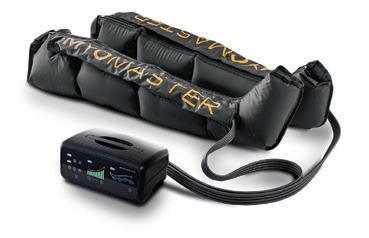
The dreaded DOMS (delayed onset muscle soreness) will be familiar to athletes returning to sport after a long lay-off or those that have pushed themselves a lot harder than usual. Feeling your muscles ache or stiffen for a few days after exercise is not unusual, but to reduce the discomfort and get you back training again sooner, you could invest in these padded sleeves that cover your entire legs and administers up to
myomaster.com US $698
Image: Myo Master
200mmHG of compression pressure to the legs for fast and effective relief from soreness. You can choose between 10, 20, and 30-minute sessions for the fastest way to fresh legs.
38
By Kenzo Shabazz-Edwards
For working (out) at home…
Flexispot Sit2Go
If your 9-to-5 involves being sat at a desk staring at a screen – whether in the office or WFH – such sedentary behaviour will play havoc with your health over time. However, with this desk bike chair, you can incorporate exercise into your daily work schedule. It comes with no expense to your comfort too with supportive seat cushions and a mesh backrest. The pedals are whisper quiet in operation – so won’t disturb your concentration or that Zoom call – but with eight resistance levels they will give you a good workout whatever your fitness level. You can track how much effort you are putting in with the LCD panel and when the working day is over you can slide the bike out of the way on its easy-rolling casters.

flexispot.co.uk
US $177
Image: flexispot.co.uk
To massage those muscles…
Theragun Elite
Hard chargers who like to push themselves in the gym or on the sports field will find injury or illness interrupts their progress if they don’t also pay attention to rest and recovery. Massage plays a key role in relieving muscle tension, improving range of motion, and combating pain and fatigue, and a muscle massage gun is trusted by professional athletes for muscle recovery. The device uses sophisticated percussive treatment to offer massages that are 60 percent deeper than a hands-on masseuse can provide. The gun’s vibrations increase circulation and allow fluids to circulate through your body, resulting in less muscle discomfort and a quicker recovery after a workout. You can connect the gun to the Therabody app and sync your treatments with Apple Health or Google Fit to view suggested fitness programs.
therabody.com
US $477
Image: Therabody International Ltd.
For beats to beat your personal best…
Fit Pro True Wireless Earbuds
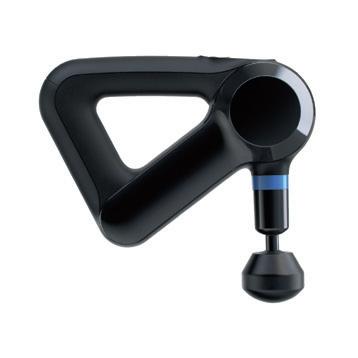

Everything is better with music, especially working out. The Beats Fit Pro True Wireless Earbuds stay put and deliver quality sound even through the most punishing training session thanks to the new flexible wingtips that tuck into your ear. The tap technology on the earbuds allowing for a seamless shift through your playlist, as well as activating noise cancellation or transparency mode. There’s even a new sound feature – spatial audio that gives your music a live feel that sounds like it is coming from all around you. When you turn your head, the audio rotates so it sounds like the music is in the same spot, just as the sound would change when you swivel your head at a real concert.
amazon.com
US $253
Image: Amazon
39 Kilimanjaro Fast Ferries book online at azammarine.com
TECHNOLOGY REVIEW

Our fleet
Experience the finest, modern and swift ferry services in Tanzania

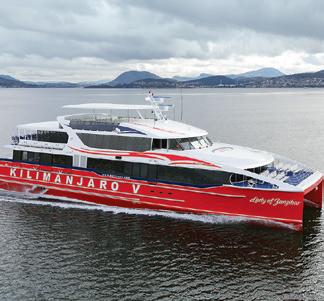


Our Catamarans
We have a fleet of eight vessels with a speed range of 25 knots up to 40 knots allowing passengers to be in Zanzibar from Dar es Salaam within 1 hour and 20 minutes.

41 Kilimanjaro Fast
book online at azammarine.com
Ferries
Kilimanjaro VIII
Kilimanjaro VI
Kilimanjaro V
Kilimanjaro IV
Kilimanjaro VII


Travel information
Our services
Onboard hospitality services:
WiFi
Free Internet on board all our catamarans

Entertainment
Library of movies and TV shows to watch
Snacks
Enjoy a cup of coffee, tea or Juice
VIP Lounge
Luxurious Lounge Dedicated to VIP and Royal class passengers.
Need to know
25 Kgs
Permitted Luggage is 25 kgs per person. Any additional will be chargeable.
Consumption and carriage of alcoholic beverages is highly restricted.
No refund policy on missed travel date or time. In case of cancellation, office should be informed at least two hours prior to departure.
Online bookings are not considered confirmed until a payment has been made.
Travel tips
All foreign passengers (not Tanzanian citizens) are required to carry their passports when traveling between the islands of Zanzibar and mainland Tanzania. Foreign passengers are required to pay for their tickets in US$. We do however accept payments in UK Pound Sterling (GBP) and Euro (€). All other currencies are not acceptable.
Foreigners with resident permits or exemption certificates are allowed to pay for their fares in Tanzanian Shillings and will be charged the normal fares applicable for citizens. Tanzanian citizens are encouraged to carry some identification to prove their citizenship. We recommend all passengers to buy their tickets from our offices in Dar es Salaam, Zanzibar or Pemba and from our approved travel agents throughout the country. Please do not buy tickets from people in the streets claiming to be our agents.
Ferry schedules
DAR - ZNZ
Dar es Salaam to Zanzibar
7 AM
9.30 AM
12.30 PM
4 PM
ZNZ - DAR
Zanzibar to Dar es Salaam
7AM
9.30AM
12.30PM
4PM
ZNZ - PEM
Zanzibar to Pemba
7.30AM (WED, THU, SAT, SUN)
PEM - ZNZ
Pemba to Zanzibar
7.30 AM (THU, FRI, SUN)
9AM (TUE)
PEM - TAN
Pemba to Tanga
2.30PM (SUN)
TAN - PEM
Tanga to Pemba
11PM (MONDAY)
43 Kilimanjaro Fast Ferries book online at azammarine.com
For further information and to book visit www.azammarine.com
Our destinations
Let us take you to Tanzania’s coastal cities and the islands of Zanzibar
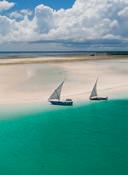
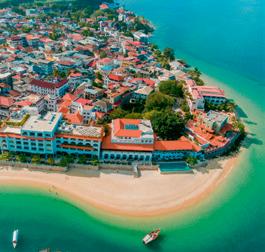
Dar es Salaam
This fast-expanding city – population four million and counting – is Tanzania’s commercial and cultural hub. Traces of Dar’s beginnings as a Zaramo fishing village can be seen at the Kivukoni front where dhows dock at dawn laden with the night’s catch for the bustling fish market, but now gleaming skyscrapers dominate the skyline. This modern metropolis rocks around the clock with a vibrant music, food and art scene, but if you prefer to relax there are a string of serene beaches in easy reach as well as the nature escapes of Pugu Hills and Mikumi National Park.

Zanzibar
Unguja, the largest island of the Zanzibar archipelago, is a treasure trove for tourists. Those who snorkel, scuba or windsurf will love its reef-protected cerulean
waters while its vibrant and unique Swahili heritage will fascinate culture vultures and its famous spices perfume the air and flavour the food. Kilimanjaro Fast Ferries delivers you to one of the island’s greatest attractions, Stone Town, the capital’s ancient port. Here you can explore its maze of bazaars, cafés, mosques and mansions that are vestiges of the island’s pivotal role in trading along the East African coast.
Pemba
As its Arabic name, which translates as “the green island”, suggests, Pemba has a lush landscape, combining the cultivated and the wild. There are plantations of banana, coconut and cloves as well as expanses of mangrove forest. With far fewer hotels than its Zanzibar big brother Unguja, 80 km south, it provides an exclusive escape for the adventurous traveller with remote attractions including the dense canopy of monkey-magnet Ngezi Forest and the private paradises of isolated sandbanks. Its white sand beaches are ringed on all sides by coral reefs which offer some of east Africa’s best snorkelling and diving – with marine life including humpback whales in July and August.
Tanga
When its sisal farming was in full flight, Tanga was earmarked as the capital of Tanzania, but it now offers more low-key charms. It still has a busy port – the second largest in the country – with our ferries crossing to Pemba – and plenty of attractions for the visitor. Its history as an Arab trading post before the Germans and British vied for colonial control in its sisal
44
Dar es Salaam waterfront Gideon Ikigai / Shutterstock.com
Pemba Island
heyday has left a town with some fascinatingly eclectic architecture, especially the gothic Bombo Hospital. The ocean offers great dhow sailing, there is a rich coral reef for diving enthusiasts and Tanga’s proximity to the Saadani National Park makes it the only city with a wildlife sanctuary incorporating a marine park in the region. Other nearby attractions include the Amboni Caves and the Swahili trading outpost of Pangani.
Contacts
Bookings: azammarine.com
+255 22 2123324
info@azammarine.com
Follow us: @azammarine
kilimanjaro fastferries
officialazammarine
Azam Marine and Kilimanjaro Fast Ferries
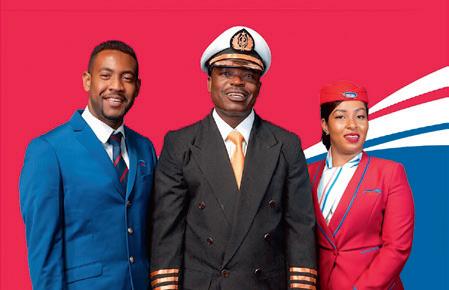
Opposite St. Joseph Cathedral Sokoine Drive, PO Box 2517
Dar es Salaam, Tanzania
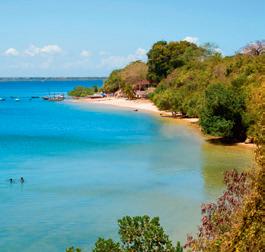
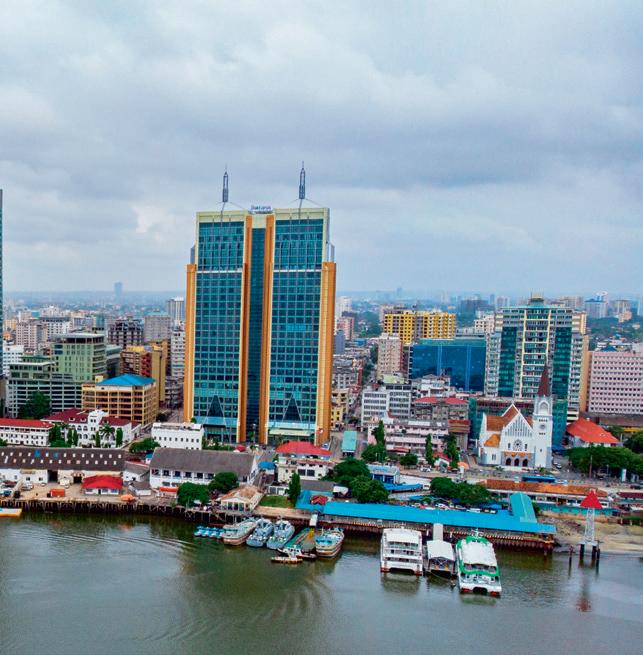
Email: info@azammarine.com
www.azammarine.com
Tel: +255 22 212 3324
45 Kilimanjaro Fast Ferries book online at azammarine.com
Tanga


46
























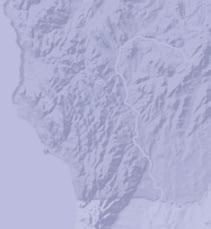













47 azammarine.com Menai Bay Conservation Area Kiwani Bay Kichwele National Forest Chumbe Island Coral P Pemba Island Routes For further information and to book visit www.azammarine.com @azammarine kilimanjaro fastferries officialazammarine Pemba Island Zanzibar Stone Town Tanga Mkoani Bagamoyo Kibaha Korogwe Wete Mkokotoni Dar es Salaam





















Pemba Island Mkoani
For further information and to book visit www.azammarine.com Pemba Island Zanzibar Stone Town Tanga Mkoani Bagamoyo Kibaha Korogwe Wete Mkokotoni Dar es Salaam
Routes

